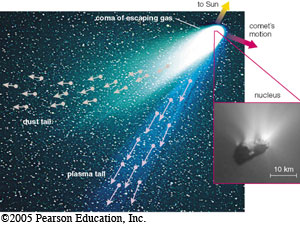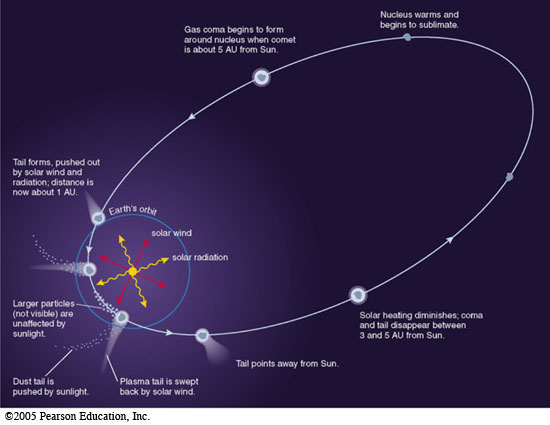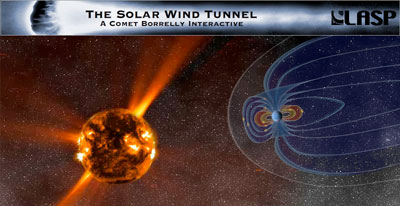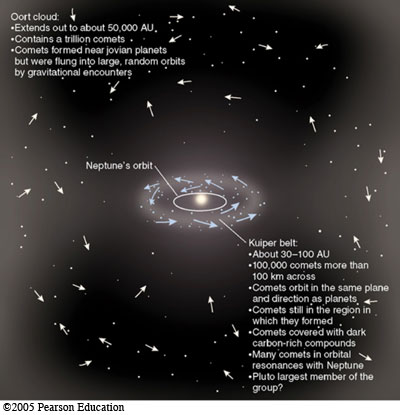
CometsComets
SUMMARY: Comets are icy planetesimals that formed in the outer regions of the solar system and assembled in two distinct regions: the Kuiper belt and the Oort cloud. Comets are rather small compared to planets and moons. The comets that visit the inner solar system are no bigger than 20 km in size — the size of a city!
The Flashy Lives of Comets
Sublimation and the Coma
Comet Tails
The Origin of Comets
Missions to Comets
Related links
The Flashy Lives of Comets
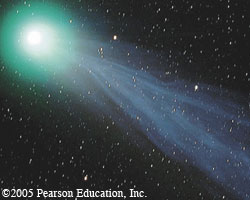
Comet Hyakutake
Photographed by Peter Ceravolo
Most comets remain undetected frozen balls of ice in the outer reaches of our solar system. The few that occasionally venture inward warm up as they get closer to the Sun and grow the long tails that we characteristically see as they flash through the sky. Comet Hyakutake, seen right, came as close as 9.3 million miles of Earth in March 1996.
Comets are completely frozen when they are far from the Sun, and most are just a few kilometers across. A comet's appearance changes as it approaches the Sun. Solar heat warms the comet, giving it the following anatomy:
- The comet nucleus is the dirty snowball that is essentially the entire comet when it is frozen and far from the Sun.
- The coma is a large, dusty atmosphere surrounding the nucleus, made up of sublimated gas mixed with dust.
- The tail consists of gas and dust that can extend hundreds of millions of kilometers away from the coma. Most comets actually have 2 tails: a plasma tail made of ionized gas, and a dust tail made of small solid particles. Comet tails point away from the Sun.
Sublimation and the Coma
As a comet accelerates towards the Sun, its surface temperature increases, and ices begin to sublimate into gaseous form. By the time the comet comes within about 5 AU of the Sun, sublimation has formed a noticeable atmosphere that easily escapes the comet's weak gravity. The coma forms as the escaping atmosphere drags away dust particles that have been mixed with the sublimating ice. More ice turns into gas as the comet approaches the Sun.
Comet Tails
Comet tails are expansions of the coma. Comet tails point away from the Sun, regardless of the direction in which the comet is traveling. Comets have two tails because escaping gas and dust are influenced by the Sun in slightly different ways, and the tails point in slightly different directions.
Gases escaping from the comet are ionized by the ultraviolet photons from the Sun. Once they are ionized, the solar wind carries them straight outward away from the Sun. These gases form the plasma tail.
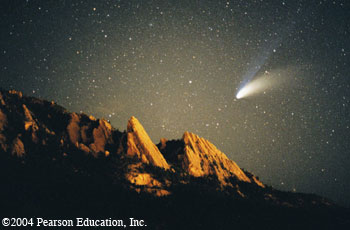
Comet Hale-Bopp over Boulder, Colorado
Additional credit: Niescja Turner and Carter Emmart
This picture of the comet Hale-Bopp was photographed over Boulder, Colorado during its appearance in 1997.
Dust-size particles that escape from the comet experience a much weaker push from the Sun caused by the pressure of sunlight itself (called radiation pressure), rather than by the charged particles of the solar wind. While the dust tail also points generally away from the Sun, it has a slight curve back in the direction the comet came from.
The picture below shows the evolution of a comet in its orbital path.
The Orbit Simulator
The Solar Wind Tunnel
The Origin of Comets
Kuiper belt comets:
- About a billion comets more than 10 km across
- About 100,000 comets more than 100 km across
- Kuiper belt comets orbit the Sun in the same direction (CCW) as the planets
- Kuiper belt comets lie close to the plane of planetary objects
Oort cloud comets:
- About a trillion comets
- Each comet is typically separated from the next by more than 1 billion km
- Oort cloud comets do not orbit the Sun in the same direction as the planets, and orbits can be pointed in any direction
- Orbits can span up to 50,000 AU
The Oort cloud is thought to have formed in the vicinity of the jovian planets where the comets were flung onto their large, random orbits by gravitational encounters with these planets.
Missions to Comets
What's so special about these random balls of ice and dust? Comets are made up of the most primitive material in the solar system. That is, their composition has changed very little in the last 4 billion years. A better understanding of their composition and origin gives scientists clues about the origin of our solar system and helps to test the theories we have built about out evolution.

(click to enlarge)
Stardust
The Stardust spacecraft was launched on February 7, 1999, and returned safely to Earth on January 15, 2006. It was the first mission dedicated entirely to the exploration of a comet, and the first mission to bring back material from outside the orbit of the Moon. The mission included a flyby of the asteroid Annefrank where the spacecraft took pictures and measurements of the mountain-sized rock. After a gravity-assist from Earth and nearly 4 years of space travel, the Stardust spacecraft reached its primary target, the comet Wild-2. The goal of the mission was to collect and store dust and carbon-based samples while flying nearest to the comet.
On January 15, 2006 Stardust released its Sample Return Capsule (SRC) into Earth�s atmosphere to descend over a U.S. Air Force testing range in Utah. Unfortunately, a parachute failure caused the capsule to crash into the desert floor and much, though not all of the data was lost. Check out the official website for the latest science results.
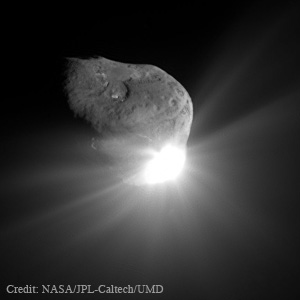
(click to enlarge)
Deep Impact
On July 2, 2005 the main spacecraft of NASA's Deep Impact mission deployed a 370-kg "impactor" into the path of the comet Tempel 1. The main spacecraft flew by, studying the impactor and the crater it produced when it crashed into the comet about 24 hours later. Scientists hoped to better understand comets by looking at how craters form and the changes the impact had on other material that is naturally out-gassed. They also measured the size of the crater, the composition of the interior of the crater and the ejected material.
You can learn more about the Deep Impact mission at the official site.
Dave Jewitt's comet home page

